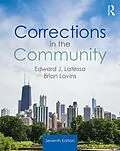Corrections in the Community, Seventh Edition, examines the current state of community corrections and proposes an evidence-based approach to making programs more effective. As the U.S. prison and jail systems continue to struggle, options like probation, parole, alternative sentencing, and both residential and non-residential programs in the community continue to grow in importance. This text provides a solid foundation and includes the most salient information available on the broad and dynamic subject of community corrections. Authors Latessa and Lovins organize and evaluate the latest data on the assessment of offender risk/need/responsivity and successful methods that continue to improve community supervision and its effects on different types of clients, from those with mental illness or substance abuse problems to juveniles.
This book provides students with a thorough understanding of the theoretical and practical aspects of community corrections and prepares them to evaluate and strengthen these crucial programs. This seventh edition includes new chapters on pretrial, and graduated responses as well as updated information on specialty drug and other problem-solving courts. Now found in every state, these specialty courts represent a way to deal with some of the most devastating problems that face our population, be it substance abuse or re-entry to the community from prison. Chapters contain key terms, boxed material, review questions, and recommended readings, and a glossary is provided to clarify important concepts. The instructor's guide is expanded, offering sample syllabi for semester, quarter, and online classes; student exercises; and research and information links. A test bank and lecture slides are also available at no cost.
Autorentext
Edward J. Latessa, Brian Lovins
Klappentext
Corrections in the Community, Seventh Edition, examines the current state of community corrections and proposes an evidence-based approach to making programs more effective. As the U.S. prison and jail systems continue to struggle, options like probation, parole, alternative sentencing, and both residential and non-residential programs in the community continue to grow in importance. This text provides a solid foundation and includes the most salient information available on the broad and dynamic subject of community corrections. Authors Latessa and Lovins organize and evaluate the latest data on the assessment of offender risk/need/responsivity and successful methods that continue to improve community supervision and its effects on different types of clients, from those with mental illness or substance abuse problems to juveniles.
This book provides students with a thorough understanding of the theoretical and practical aspects of community corrections and prepares them to evaluate and strengthen these crucial programs. This seventh edition includes new chapters on pretrial, and graduated responses as well as updated information on specialty drug and other problem-solving courts. Now found in every state, these specialty courts represent a way to deal with some of the most devastating problems that face our population, be it substance abuse or re-entry to the community from prison. Chapters contain key terms, boxed material, review questions, and recommended readings, and a glossary is provided to clarify important concepts. The instructor's guide is expanded, offering sample syllabi for semester, quarter, and online classes; student exercises; research and information links; and a transcription of the Bill of Rights. A test bank and lecture slides are also available at no cost.
Inhalt
About the Authors
Preface
Acknowledgments
1. The Criminal Justice System
2. Pretrial Bond, Bail, and Diversion
3. Sentencing and Community Corrections
4. Probation in America
5. Parole in America
6. Offender Assessment
7. Roles of Probation and Parole Officers
8. Supervision Strategies and Delivering Services to Offenders
9. Graduate Responses to Behavior
10. Community Residential Correctional Programs
11. Special Populations in Community Corrections
12. Women and Community Corrections
13. Problem-Solving Courts
14. Evaluating Community Corrections
15. The Future of Corrections in the Community
Glossary/Index
